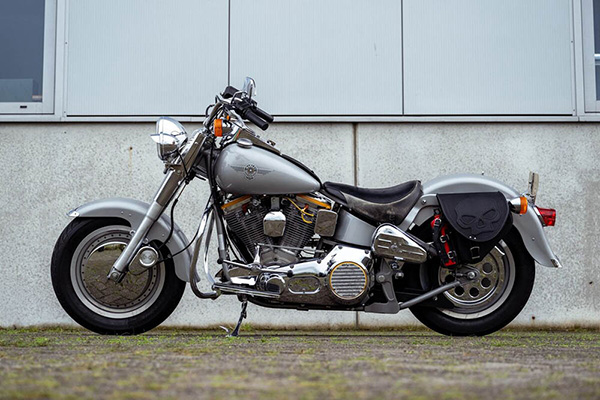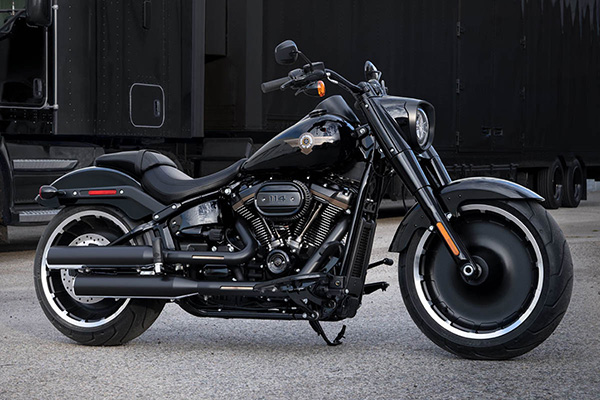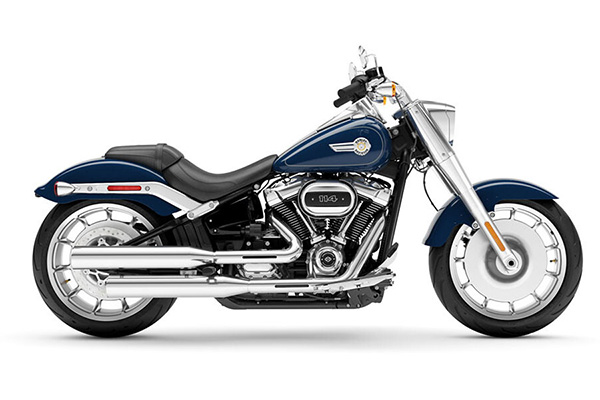28 March 2025
One of the most famous names from one of motorcycling’s most famous manufacturers, Harley-Davidson’s Fat Boy combines distinctive looks, a silver screen pedigree, and notable name to stick in the mind of all those who see one – whether they’re a motorbike fan or otherwise.
Founding the Fat Boy

The first version was launched in 1990, though of course planning started a few years earlier. A series of large changes to how Harley-Davidson was operated. Following an investment round in 1981, Willie G. Davidson – grandson of one of the four founders of the company – had been Chief Styling Officer for a number of years, and worked on a series of bikes that paved the way for the Fat Boy.
By designing the likes of the FXST in 1984, and then the FLST Heritage Softail in 1986, the heritage looks featured were hugely popular with buyers. Following the 1988 FXSTS Springer Softail, the road was right on track to the invention of Harley’s Fat Boy.
Starting with a Heritage Softail as its foundations, Davidson worked with co-designer Louie Netz to create a bike with more minimalist, more industrial styling, inspired by 1950s machines.
Design deflourishing
The Fat Boy did away with elements of the Heritage Softail, such as the wide expanses of chrome about the bodywork and saddle. Added were solid aluminium disc wheels, a new front fender with virtually no chrome, and ‘shotgun’ double exhaust.
It was far from a styling exercise too, with extensive testing over around two years that only helped refinement, and reinforced the hewn rather than built aesthetics.
Powered by a 1,340cc Evo V-twin, Willie G. tested public opinion by riding a prototype to Daytona Bike Week in February 1988, and again a year later. These trips helped hone the styling, and brought about details such as monochromatic paint with yellow detailing, lacing on the seat and fuel tank, and a written ‘Fat Boy’ emblem.
What’s in a name?

There have long been murmurs of why the Fat Boy was called what it was; but they are in fact apocryphal. The mention of merging the names of the atomic bombs dropped on Japan at the end of World War II – Fat Man and Little Boy – as well as the colour scheme matching the B-29 bombers which dropped them, and even the solid wheels reflecting aviation wheels… all rubbish, despite how intriguing the thought might be.
In fact, Willie G. said himself in his book on the company published in 2002, before his retirement in 2012: “You are probably wondering how we were able to decide to choose a name like Fat Boy.
“I have heard many stories about it, almost all of which are false. Here’s the real story: it’s hard to find names that will win everyone’s support. We always wondered, ‘How are people going to nickname this machine?’ And we worked by reflecting with this question in mind.
“We were looking for the unusual and maybe even a little irreverent. For me, and for many of the other collaborators who had seen it, this motorcycle had a massive, fat look. So the marketing people have come up with the name Fat Boy. And everyone adopted it.”
Throw in a truly memorable cameo in Terminator 2: Judgement Day, and a series of evolutions over the years, including new exhausts, engines, gearboxes, and in 2018 a new chassis, and it’s understandable why the Fat Boy has persevered over more than 30 years.


COMMENT